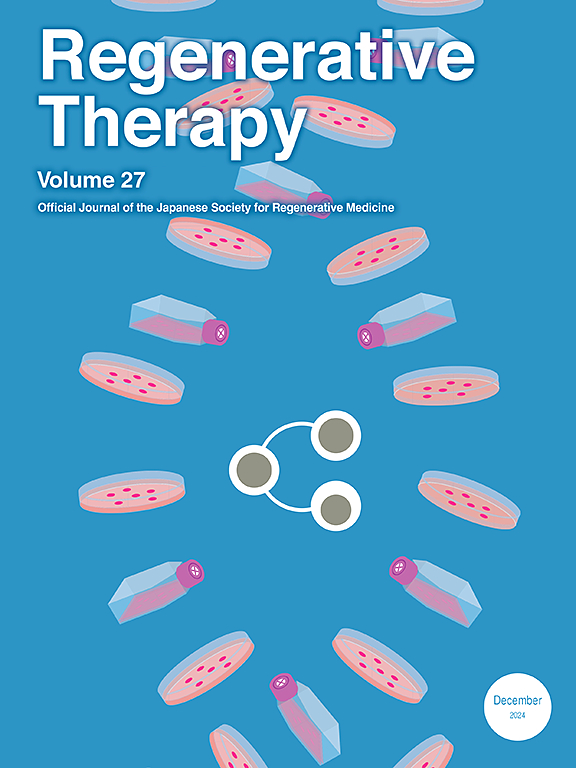通过mmu- mir -874-3p介导的wnt/β-catenin信号通路激活,bmscs来源的外泌体减轻了顺铂诱导的急性肾损伤
IF 3.5
3区 环境科学与生态学
Q3 CELL & TISSUE ENGINEERING
引用次数: 0
摘要
急性肾损伤(AKI)在30% - 46%的患者中由顺铂化疗药物引起,但缺乏临床有效的预防和治疗方法。骨髓间充质干细胞衍生的外泌体(BMSCs-exo)在组织修复中具有潜力,但其减轻顺铂诱导的肾损伤的机制尚不清楚。目的探讨骨髓间充质干细胞外显子(BMSCs-exo)对顺铂性AKI的治疗作用,并分析其关键分子机制。方法和材料采用超离心提取bmscs -exo,并通过透射电镜、纳米颗粒分析和Western blot对其进行鉴定。将C57BL/6小鼠分为对照组(Con)、顺铂模型组(Cis)和BMSCs-exo治疗组(BMSCs-exo),动态检测肾功能。PAS染色观察小鼠肾组织病理变化,免疫组化检测Wnt4、β-catenin、FZD5、CD31及肾小管损伤标志物NGAL、KIM1的表达水平。Western blot检测Wnt4、β-catenin、FZD5、CD31的表达。采用高通量测序筛选差异mirna,并对靶基因进行GO/KEGG富集分析。结果Cis组大鼠血肌酐、尿素氮水平明显高于Con组,肾小管上皮细胞出现坏死,证实AKI模型建立成功。通过NGAL和KIM1的表达证实,BMSCs-exo减轻了体内肾功能障碍、组织病理学改变和肾小管损伤。我们进一步证明BMSCs-exo特异性定位于受损肾脏。Con、Cis和BMSCs-exo组肾组织的MiRNA测序发现,富含Wnt信号通路和血管生成途径的mmu- mir -874- 3d - p是BMSCs-exo的肾保护作用的关键介质,FZD5是其下游靶点。此外,BMSCs-exo治疗可显著防止微血管丢失。在BMSCs-exo组中,Wnt4、β-catenin和CD31表达上调,而FZD5表达下调,与免疫组化结果一致。结论bmscs -exo通过减轻对肾微血管和小管上皮细胞的损伤来保护肾脏免受顺铂诱导的AKI(Cis-AKI),主要是通过免疫球蛋白- mir -874- 3d - p介导的抑制FZD5的激活和促进Wnt/β-catenin通路的激活。本文章由计算机程序翻译,如有差异,请以英文原文为准。
Cisplatin-induced acute kidney injury is alleviated by BMSCs-derived exosome via mmu-miR-874-3p-mediated activation of the wnt/β-catenin signaling pathway
Background
Acute kidney injury (AKI) results from cisplatin chemotherapeutic agents in 30 %–46 % of patients, but clinically effective preventive and therapeutic approaches are lacking. Bone marrow mesenchymal stem cells-derived exosomes (BMSCs-exo) have potential in tissue repair, but the mechanism by which they attenuate cisplatin-induced kidney injury is unknown.
Objective
To explore the therapeutic effect of BMSCs-exo on cisplatin-induced AKI and to analyze the key molecular mechanism involved.
Methods and materials
BMSCs-exo were extracted via ultracentrifugation and identified via transmission electron microscopy, nanoparticle analysis and Western blot. C57BL/6 mice were divided into a control group (Con), a cisplatin model group (Cis), and a BMSCs-exo treatment group (BMSCs-exo), and renal function was dynamically tested. PAS staining was used to observe histopathological changes in mouse kidney tissues, while immunohistochemistry was employed to assess the expression levels of Wnt4, β-catenin, FZD5, CD31, and the tubular injury markers NGAL and KIM1. Western blot was used to detect the expression of Wnt4, β-catenin, FZD5 and CD31. High-throughput sequencing was used to screen for differential miRNAs, and GO/KEGG enrichment analysis of target genes was performed.
Results
Blood creatinine and urea nitrogen levels were significantly higher in the Cis group than in the Con group, and renal tubular epithelial cells exhibited necrosis, confirming successful AKI model establishment. BMSCs-exo alleviated renal dysfunction, histopathological alterations, and tubular injury in vivo, as evidenced by NGAL and KIM1 expression. We further demonstrated that BMSCs-exo specifically localized to the injured kidney. MiRNA sequencing of renal tissues from the Con, Cis and BMSCs-exo groups identified mmu-miR-874-3p—enriched in Wnt signaling and angiogenesis pathways—as a key mediator of the renoprotective effects of BMSCs-exo, with FZD5 as its downstream target. Moreover, treatment with BMSCs-exo markedly prevented microvascular loss. In the BMSCs-exo group, Wnt4, β-catenin and CD31 expression were upregulated, whereas FZD5 expression was downregulated, consistent with the immunohistochemistry results.
Conclusions
BMSCs-exo protect kidneys against cisplatin-induced AKI(Cis-AKI) by attenuating injury to the renal microvasculature and tubule epithelial cells, primarily through mmu-miR-874-3p-mediated inhibition of FZD5 activation and promotion of Wnt/β-catenin pathway activation.
求助全文
通过发布文献求助,成功后即可免费获取论文全文。
去求助
来源期刊

Regenerative Therapy
Engineering-Biomedical Engineering
CiteScore
6.00
自引率
2.30%
发文量
106
审稿时长
49 days
期刊介绍:
Regenerative Therapy is the official peer-reviewed online journal of the Japanese Society for Regenerative Medicine.
Regenerative Therapy is a multidisciplinary journal that publishes original articles and reviews of basic research, clinical translation, industrial development, and regulatory issues focusing on stem cell biology, tissue engineering, and regenerative medicine.
 求助内容:
求助内容: 应助结果提醒方式:
应助结果提醒方式:


